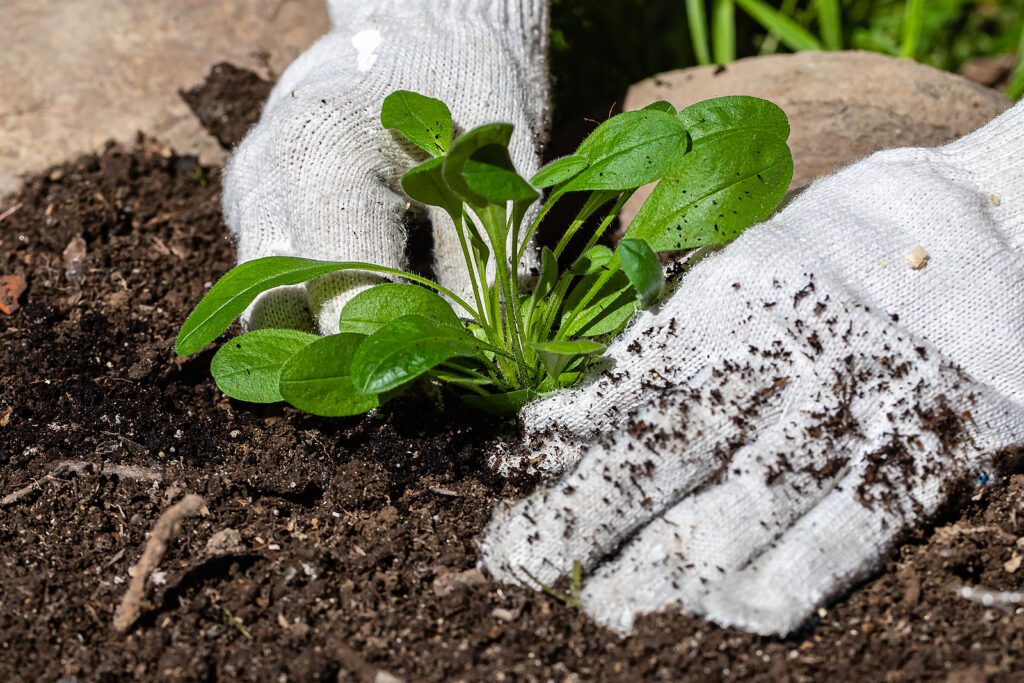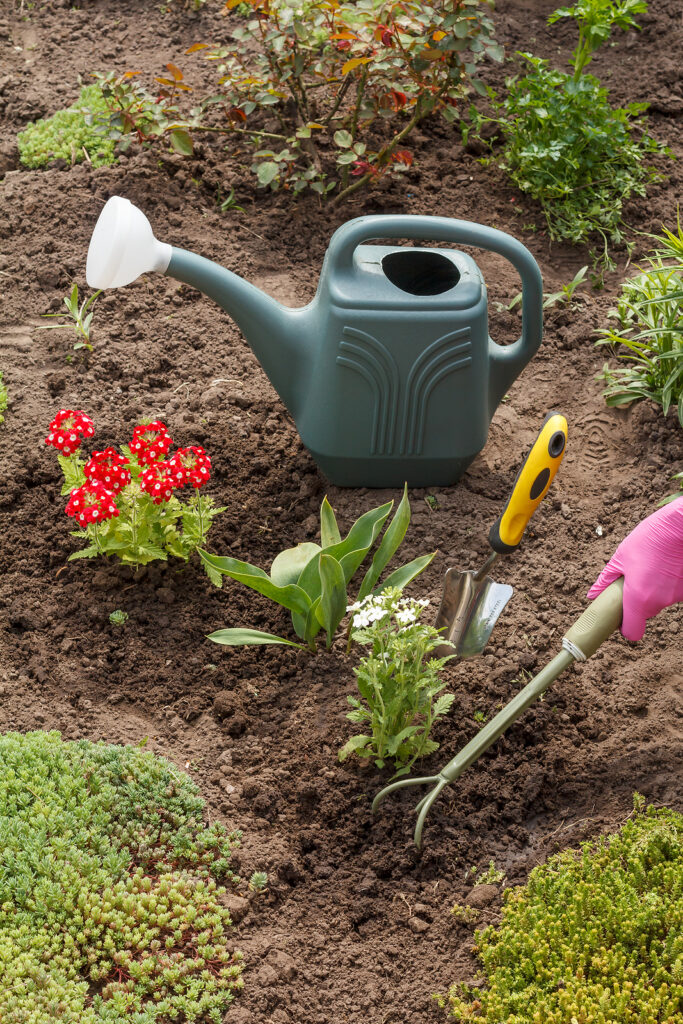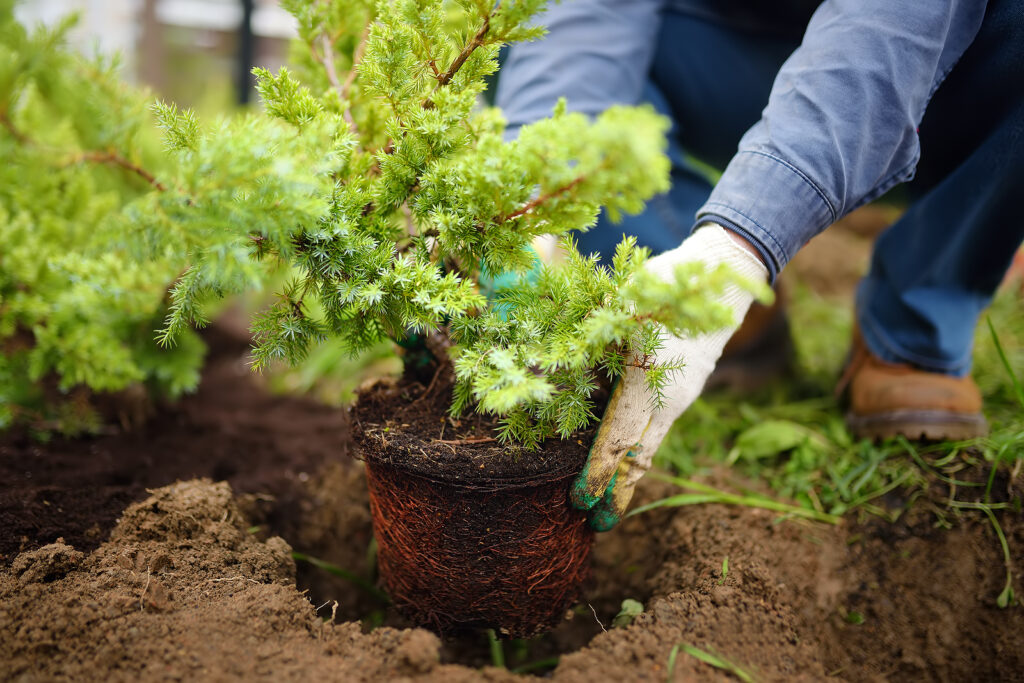Transplanting is the process of removing plants from one place and resetting them in another. Small plants such as seedlings and large plants such as trees can be transplanted.

Transplanting seedlings
When small seedlings are lifted from the rows in seed flats, cell packs, or pots, separated and replaced in other pots, the term “pricking out” is generally used. “Pricking out” is simply transplanting small plants.
The first transplanting of seedlings is done to give them space in which to develop until, a few weeks later, they are either potted or planted in more permanent quarters. Crowded seedlings quickly become slender or spindly, weak, and useless. That’s why transplanting is necessary.
Early spring plants are commonly started indoors and then transplanted out into cold frames and or into the garden. Seedlings can also be started in a cold frame, plastic tunnel, or seedbed and later transplanted to their permanent home in the garden.

What happens when seedlings are transplanted
Transplanting almost invariably injures some of a seedling’s delicate feeding rootlets. This often checks the growth of the plant to some extent. However, there are benefits to transplanting including the stimulation and development of a good, compact root system—when transplanting is done right.
Transplanting in four steps
First, plants to be pricked out or transplanted should be prepared for the process. With seedlings and small plants, this means watering them well several hours before they are to be moved; this makes them plump and tends to prevent the soil from falling form their roots.
Second, the soil where a seedling is to be placed should be freshly dug, finely raked, and moist (but not wet) so as to help the young plant to become established and soon resume normal growth.
Third, if the loss of roots is unavoidable, part of the top of the plant (leaves) should be removed to balance the loss of roots.
Fourth, transplanted plants, should be shaded from the full sun for a few days.

After transplanting
Generally, the younger the plant the more likely it is to survive transplanting and avoid suffering setbacks in growth. Short, stocky, herbaceous plant transplant better than weak, spindly (“leggy”) ones. Those started indoors but gradually introduced to outdoor conditions such as lower temperatures and strong sunlight will resist unfavorable weather better than those not prepared for the outdoors.
Plants that have been pricked out and transplanted once or twice while small or root-pruned will withstand the shock of final transplanting because the preliminary processes restricted the roots to a smaller area. Consequently, they suffer less root injury when moved.
How to insure transplanting success
Always transplant in cloudy, cool, and damp weather if possible; or at least wait until the cool of the evening. If the next day is hot or windy, cover the plants to prevent excess evaporation.
Firming the soil about the roots of transplanted plants is important because it stimulates the rise of soil moisture to the plant’s roots. That said, the soil surface should be loose, not compacted. A compacted soil surface evaporates more water than a loose one; the surface soil should be stirred and loosened immediately after the plant is transplanted. Loose soil on the surface can be supplemented with aged compost or other loose material to stem soil moisture evaporation and protect plant roots from heat and cold.
Newly transplanted seedlings and plants should be deeply watered. For best results create a shallow basin of loose soil around each plant and fill it once or more with water before mulching the plant. Wait until the water has sunk in and the soil formed a slight crust; then loosen it an inch or so deep before it really bakes.
Plants with tap-roots transplant with difficulty, unless the main vertical root is cut while still small and thus made to send out horizontal side roots. Plants will considerable foliage compared to the size of the roots (such as lettuce and cabbage) may also prove difficult to transplant unless the amount of leaf surface is reduced by one-third.
Potted plants and those grown in transplanting pots such as biodegradable pots transplant more easily because the roots are compactly surrounded by a ball of earth. Plants in pots should be well moistened before the plant is set out.

Transplanting shrubs, woody vines, and trees
Shrubs, woody vines, and trees are usually transplanted while dormant or for evergreens in a cool time of the year when growth is slowed. Here are recommendations for transplanting larger plants:
- Any broken or injured roots should be cut back to sound wood.
- The planting hole should be dug wide and deep enough to accommodate all the roots without having to bend or overlap them.
- The topsoil and subsoil from the hole should be placed in separate piles, and in filling the hole use the topsoil first working it well around the roots with your fingers or a blunt stick.
- Settle the soil well by watering or tamping it firmly; tamp with the heel of your hand.
- Add the subsoil in after the topsoil and firm it in as well.
- Leave a depression around the plant so that rain or water applied in dry spells will soak into the roots and not away from them.
- After planting, the branches should be pruned to balance any loss of roots and to start the formation of the top of the plant.
Large shrubs and trees are best transplanted in winter when growth is slowed and the soil is most firm and compact from winter weather.
Nursery grown trees and large shrubs with compact root systems will be easier to transplant than wild plants with shallow or spreading roots that are sure to be injured.



